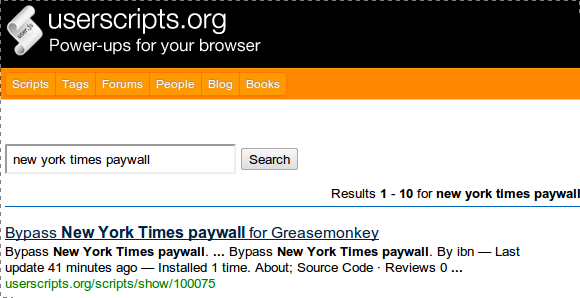Did you know that the New York Times spent an incredible $40 million on their recent paywall solution? Did you also know that it can be circumvented with all but a few clicks? There are in fact a surprising number of methods that currently allow you to browse the NY Times for free, despite the small fortune involved in protecting this content. As newspapers take slow, unsure steps in a bid to generate revenue online, clearly there are still lessons to be learned.
If you're interested in how the Internet has rendered $40 million worth of effort redundant, then read on.
A Quick Word Before We Begin
This article is designed to demonstrate just how easy it is to get around protection like this, and is certainly not meant to deprive the New York Times or its journalists of money. We here at MakeUseOf are not the authors of any such techniques.
We do however feel this is within our readers interests, hence this article. If you do feel particularly strongly about this issue then be sure to have your say in the comments, at the bottom of this article.
Clearing Cookies
Currently the paywall does not use IP (Internet Protocol) addresses to track visits. The site also allows you 20 free articles per month, and these are tracked using cookies. If you were to browse 20 articles using Chrome, you'd then be free to browse another 20 in Firefox, Internet Explorer, Safari and so on as the cookies are browser-unique.
So, by this logic (you probably don't want to go swapping browsers just to read the news) you can simply clear your cookies and continue browsing. The only problem with clearing all your cookies is that other sites you regularly visit and rely on may forget who you are.
Using JavaScript, Digital Inspiration created a bookmarklet to clear the NY Times cookies alone. Drag the Remove NYT Cookies link into your bookmarks bar and click it every 20 articles or so to reset the counter to zero.
Note: Disabling cookies in your browser altogether won't work, as the site requires cookies to function.
Removing The Overlay
Once you've hit article number 20, any subsequent articles you attempt to access will present you with an overlay, which will stop you being able to scroll the page and view the content beneath the “buy a subscription” box.
Dave Hayes of euri.ca has come up with a bookmarklet that, when clicked, removes that pesky overlay and restores your ability to scroll. Drag the NYTClean bookmarklet onto your bookmarks bar, and every time you hit the paywall, click it. You'll see the overlay disappear and you'll be free to read the article again.
The Google Approach
If you really want access to an article behind a paywall, you can (for a few articles) use Google. Searching for the full article title or URL in Google should bring up the article you're looking for as the top search result.
As many websites consider the “first click free”, you should be able to view the article as you are coming from a search engine result. To read your next article, repeat the process and click through from your search results. You should get 5 free articles a day using this method.
This technique has been known to work on other paywalls, including the Wall Street Journal and Financial Times.
The Social Backdoor
As the newspaper is keen on building up its social networking grunt, for the time being articles that are accessed via Facebook or Twitter are free to read. You don't necessarily have to follow every story as you can use this page to find Twitter feeds that are relevant to your interests.
It's worth mentioning that the paper has stipulated if this method of accessing content is abused then this perk will be withdrawn. How soon this will happen remains to be seen – there's not much point following the paper on Twitter if you can't click the articles, is there?
You can also follow @freeUnnamedNews for NY Times articles as they're published.
Browser Extensions
Firefox users can install Greasemonkey (and Safari users Greasekit) to run user scripts (like this one at userscripts.org) that claim to get around the paywall. Just be careful when installing scripts from sources like this, and disable them when you're not browsing the NY Times.
There was a Chrome extension that did this with 2 lines of CSS, but Google took it down and the NY Times modified a class or two.
Conclusion
The decision to put online content behind a paywall comes with plenty of issues. By hiding content altogether search engine optimization suffers. On the other hand leaving content in an easily accessible online location is bound to result in a similar debacle.
These five techniques probably won't last for long, as the newspaper is bound to try and protect its content in other ways. This article hopefully provides some insight into the problems faced by traditional print news outlets and the difficulty in protecting content destined for both keen readers and search engine traffic.
What do you think of the NY Times paywall? Have you browsed the site via one of the methods above? Any other techniques? Give us your ethical, technical and financial reports in the comments below.
Image Credit: Shutterstock






